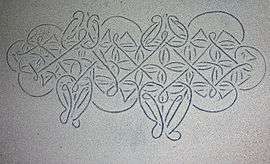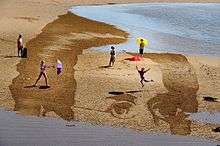Sand drawing
Sand drawing (or sandroing in Bislama)[1][2] is a ni-Vanuatu artistic and ritual tradition and practice, recognised by UNESCO as a Masterpiece of the Oral and Intangible Heritage of Humanity.[3][4]


Another form of art which implies drawing in the sand is sandpainting, but this process also implies the coloring of sand to create a colorful environment on a small or a large scale.
Description
Sand drawing is produced in sand, volcanic ash or clay. It consists of "a continuous meandering line on an imagined grid to produce a graceful, often symmetrical, composition of geometric patterns". The artist's implement is a single finger.[3]
UNESCO describes sand drawing as:
A rich and dynamic graphic tradition [which] has developed as a means of communication among the members of some 80 different language groups inhabiting the central and northern islands of Vanuatu. The drawings also function as mnemonic devices to record and transmit rituals, mythological lore and a wealth of oral information about local histories, cosmologies, kinship systems, song cycles, farming techniques, architectural and craft design, and choreographic patterns. Most sand drawings possess several functions and layers of meaning: they can be “read” as artistic works, repositories of information, illustration for stories, signatures, or simply messages and objects of contemplation.[3]
Artists such as Pablo Picasso were known for drafting their visual ideas in the sand. Norman Joseph Woodland, inventor of the barcode, came up with his invention by drawing it in the sand.[5]
Correlated forms of art
Sand drawings are associated with the Indian sand mandalas because of the geometry-driven shapes it delivers through the manipulation of sand. The work of making patterns in the sand with a rake is also evocative of the Karesansui practice in tradition Japan rock gardens, and of the large scale Nazca Lines in Peru.[5]
Since the traditional art of sand drawing is so precisely geometrical, academic research is being led to associate the (ethno-) mathematical patterns held in this art, and correlate it with modern mathematics to get a sense of the potential scientific knowledge carried by the builders of the civilizations practicing it.[6] The ancient Greek mathematician studying geometry by drawing figures in the sand also leads to the idea that traditional Sandroings convey much more than a pleasing visual effect.[7]
Vanuatu (Sandroings)
The Vanuatu Cultural Centre has noted that the spirit of sand drawing tends to disappear, only a few practitioners still master the special techniques of sand drawing. Nowadays, this form of art is mainly used as a graphic layout for advertising or tourism ends, and its original sense and purpose is getting lost. A National Action Plan for the Safeguarding of Sand Drawing has been initiated by the Centre, together with the Save Sand Drawings Action Committee; the programme is sponsored by UNESCO. The project notably led to a National Sand Drawing Festival, as from 2004.[4][8]
The Turaga indigenous movement based on Pentecost Island write using Avoiuli, an alphabet inspired by designs found in traditional sand drawings. Sand drawing is interpreted as a key visual medium in a country where more than 100 languages are spoken[8].
Pitjantjatjara (Milpatjunanyi)
In the Pitjantjatjara dialect of North Central Australia, the word Milpatjunanyi means "the art of telling stories in the sand". In this culture, the storytellers, often women, have a ritual approach to the process, using a stick that is first pressed against the body to create a connection, and also used as a drumstick to bring musical rhythm to the story. The sand drawing communication technique is also used in schools.[5]
Artists
Non-traditional artists
- Jim Denevan, American chef and artist from the surf culture, creates large scale sand drawing on California beaches during low tides.[9]
- Andres Amador, American computer technician turned sand artist, draws large-scale organic patterns on beaches, mainly in the Pacific.[10]
- Andrew Magdy, Egyptian lawyer turned sand artist, draws precise small-scale work on glass boards.[11]
- Michael Heizer, American land artist who created large scale sand drawings in the Nevada desert with the trail of his motorcycle (Double Negative, 1969-1970).[5]
- Andy Goldsworthy, British land artist, author of Dark Dry Sand Drawing in 1987, which inspired a generation of Western sand artists.[5]
See also
- Sandpainting
- Kolam – Tamil sandpainting
References
- "Sandroing", Vanuatu Cultural Centre
- Australian Broadcasting Corporation – Lingua France – Vanuatu Sand Drawing
- "Proclamation 2003: 'Vanuatu Sand Drawings'", UNESCO
- "The National Action Plan for the Safeguarding of Sand Drawing" Archived 2006-04-23 at the Wayback Machine, Vanuatu Cultural Centre
- Michael Welland (2009). Sand: The Never-ending Story. University of California Press. ISBN 9780520254374.
- Eric Vandendriessche (2014). "String Figures and Sand Drawings from Vanuatu: A Comparative Study of Mathematical Practices". Mpiwg-berlin.mpg.de. Retrieved 13 October 2018.
- Peter Prevos (2 January 2018). "Sand Drawings from Vanuatu: Four Layers of Meaning in Sandroings". Horizonofreason.com. Retrieved 13 October 2018.
- Craig Alan Volker; Fred E. Anderson (15 February 2015). Education in Languages of Lesser Power: Asia-Pacific Perspectives. John Benjamins Publishing Company. ISBN 9789027269584.
- "Amazing Sand Drawings on California Beaches". Boredpanda.com. Retrieved 13 October 2018.
- Nathaniel Ross (17 October 2015). "Andres Amador's Awe-Inspiring Sand Drawings Wash Away with the Tide". Inhabitat.com. Retrieved 16 October 2018.
- Nourhan Magdi (28 April 2018). "Sand Storytelling". Egypttoday.com. Retrieved 16 October 2018.
- Joseph Flahert (6 February 2015). "Disney invents an adorable robot for making giant sand drawings". Cnn.com. Retrieved 16 October 2018.
- "The sand-drawing robot and other tech news". Bbc.com. 6 July 2018. Retrieved 16 October 2018.
